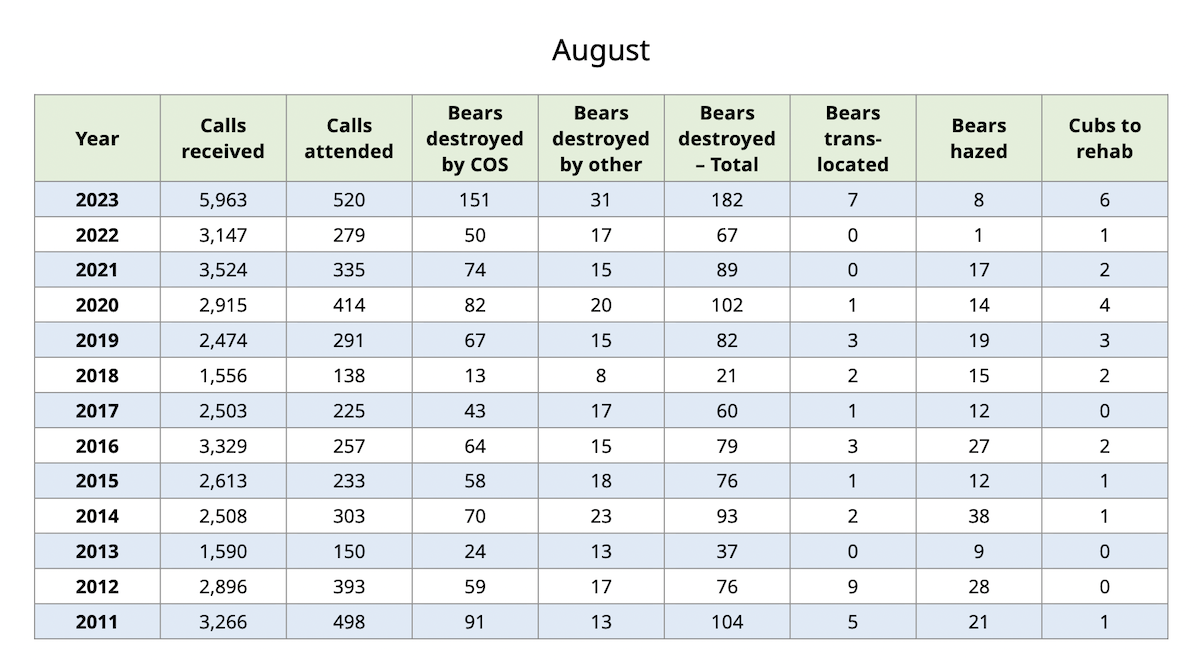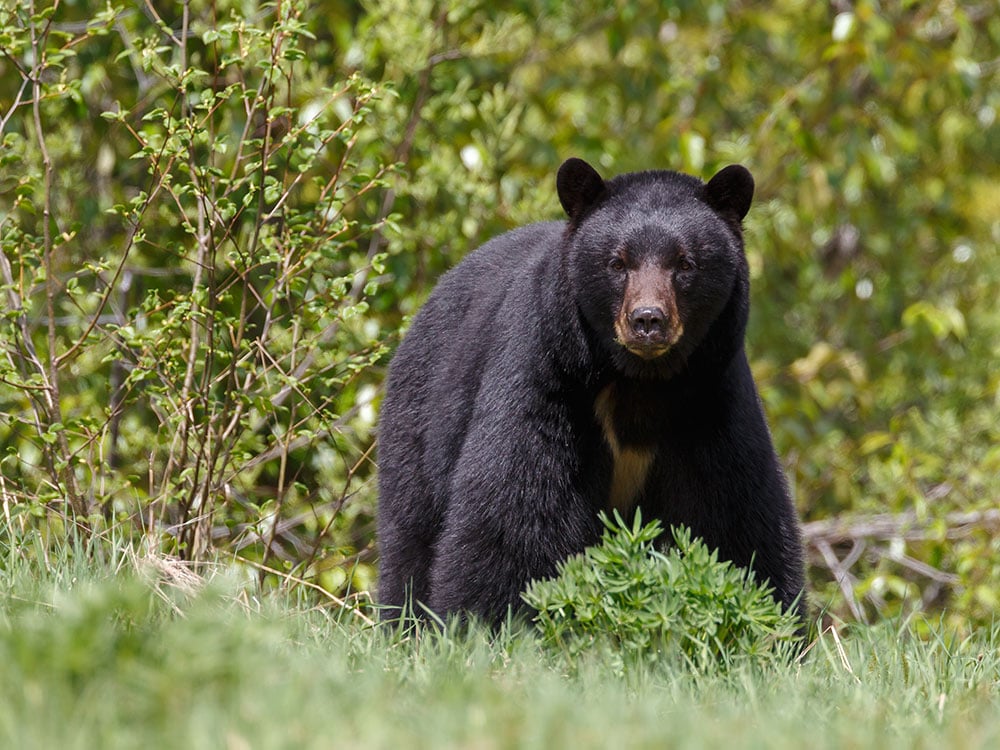2023 was a “record” year for bear killings in B.C. The rate consistently reported by media was 603 kills.
But the full data offers a clearer picture.
In 2023 there were 27,356 calls for service relating to black bears, 2,435 call attendances, and 603 incidents of lethal force on bears.
This means 91 per cent of the calls had no response — just under 9 per cent of them resulted in physical attendance by an officer.
Kill data needs better presentation
Provincial kill data is poorly constructed. While volumes are important as a baseline measure of public knowledge of reporting systems, human population increases, and conflict trends in green spaces, they are not suitable in assessing how appropriate an individual officer’s actions are when exercising lethal force on a bear.
If we’re looking at the rate of kills (603) to attended calls (2,435), the kill rate is around 25 per cent. So 75 per cent of uniformed officer responses in 2023 did not result in the death of a bear.
If we’re comparing the kills to actual call total (27,536) — the rate of lethal force is a mere 2.2 per cent. Not statistically significant.
But broad call volumes can be artificially inflated. This has been a major factor since the 1990s, when the Report All Poachers and Polluters call system, or RAPP, was launched. RAPP quickly morphed into a general call line for any public concern relating to wildlife. Its heavy promotion by the province meant a high number of calls were coded by the B.C. Conservation Officer Service as nuisance calls — calls that do not generally require an armed policing response from a conservation officer.
Nuisance calls are just one of a variety of codes received by the service. Emergency or public safety calls designated as wildlife conflicts become either a problem wildlife occurrence report or an enforcement routing sheet. Problem wildlife occurrence reports can be handled in four ways — no response, advice provided, hazed, or destroyed.
The provincial policy on animals coded as problem wildlife, or with a history of negative public interactions, is generally destruction. It is not the officer’s job to perform a health assessment or take into consideration broader wildlife management needs or public desires.
Nuisance calls or out-of-scope response needs, such as those from traffic collisions or wildfires, are included but not distinguished in the kill data. If 10 bears are euthanized because of injury from forest fires, those deaths would be included, artificially inflating the kill numbers and impacting public perception.
Proper analysis can only be compiled if there is full access to the dataset and government incident reports. But even with that access, previous research shows the public cannot discern between appropriate or inappropriate levels of force on wildlife.
Taking this into account is essential in responding to public outrage for a few reasons.
Why ‘no response’ categories are important
A large percentage of bear calls over the past decade, as in 2023, were not attended by the BC Conservation Officer Service at all, suggesting discretionary call screening favoured non-lethal response.
No public credit is given to those officers who, day in and day out, make the initial call to “ignore” nuisance calls. They save countless bears, year after year. I have known many such officers personally.
The data over the last decade is very clear: many bear kills are mandate-driven and not the direct fault of individual officers. The provincial policy expectation for a public safety and emergency response by an officer once they show up is often lethal force. But the majority of conservation officer bear responses do not result in the death of a bear.

Killing or not killing a bear
For many hunters, the relationship between hunting for food and killing for sport or trophy is a question of personal ethics. It is a divisive moral issue within the hunting community.
Some conservation officers enjoy hunting for work and see the job as that of a government hunter. I have known many that fit this bill.
Others see the role as an environmental police officer — bound by the timeless rules of constabulary independence, use of minimal force and justifiable action.
Speaking holistically about the conduct and motivations of all officers is not only inaccurate, but harmful.
I am not a hunter, but I have killed bears as a conservation officer and take the role of environmental policing very seriously.
It is true that hunting skills are sometimes invaluable to the role. The issue is when a small minority of officers with hunting ideologies displace well-grounded policing principles. Like all large organizations, the B.C. Conservation Officer Service has some members that have fermented an unhealthy culture outside the policy and policing structure.
The clearest case is the killing of what are referred to as “cubs of year” — in other words, bears under 13 months old. A yearling, juvenile, sub-adult, dispersing sub-adult, and adult or mature bear are not “cubs.” There are no rehabilitation facilities provincially for bears that are not cubs.
I have written extensively about ending the state-supported kill orders for cubs of year. I have publicly called for body cameras to be issued and for assault style rifles to be strictly controlled.
A century of BC environmental law
Environmental provincial police and the history of game laws enforcement have been directly tied to pro-hunting organizations in B.C. for over a century. The establishment of environmental law in B.C. dates back to 1858.
Today, the province’s conservation service is not a wildlife management agency but a group of provincial police constables with a primary broad environmental mandate. Between 1905 and 1920, the formalizing of environmental law enforcement as a specialized policing area began under the direction of the provincial game warden. Various game associations in the province directly funded their positions, salaries and expenses.
This history regularly feeds current public beliefs about a hunting culture in the service.
The terms “game warden,” “bush cop” and “game constable” were replaced in the early 1960s with the title “conservation officer,” but the term was not defined in law until 2003 when the service was formalized in legislation as a law enforcement agency under Section 106 of the Environmental Management Act.
The legislation states that a chief conservation officer can appoint anyone he sees fit as a conservation officer. But the service was never properly designated as a police agency under Section 4.1 of the Police Act and liabilities for non-constabulary actions remained outside of Section 11 for wildlife kills and other administrative functions. Despite this, all officers were given unrestricted individual policing appointments “without limitation” under Section 9 of the Police Act, making them provincial police.
The Environmental Management Act deviates from the Police Act and diverges from the centuries of history involving the constabulary, policing and games laws enforcement. As a result, the BCCOS is a powerful agency that operates as a police agency and employs police officers, but which was never properly designated in law.
No further role in general bear responses
Modern oversight and transparency of the conservation officer service is needed. Today, officers are fully appointed under the Police Act, and modern police accountability mechanisms apply. But tools focused on wildlife assessment necessitate separate oversight.
If Section 106 of the Environmental Assessment Act was included as a standalone section in the Police Act in respect to game laws enforcement, it would maintain the consistency of provincial armed policing services.
The current mainstream media narratives against the service are not fair. They teeter on potential and critical misrepresentation of my long-standing calls for change in the service.
In short: the service is understaffed. But it needs additional resources for environmental policing, not preventative wildlife management work.
I have participated in the B.C. legislature’s all-party review of the Police Act, and I have advocated for legislative reform of the conservation officer service. I have never called for the service to do more wildlife management work or to be mandated to proactively intervene in animal health assessments or other administrative actions governed by different ministries. I never will.
Conservation officers should attend even less wildlife conflict related calls than they do now. They should exercise their constabulary policing authorities in an independent and accountable manner and decline directives from ministry staff, executives, biologists and veterinarians who are not within the statutory chain of command.
To advocate for the conservation officer service to be more of a wildlife management agency is a fundamental error in understanding the service, its authorities, and its future. ![]()
Read more: Rights + Justice, BC Politics, Environment

















Tyee Commenting Guidelines
Comments that violate guidelines risk being deleted, and violations may result in a temporary or permanent user ban. Maintain the spirit of good conversation to stay in the discussion and be patient with moderators. Comments are reviewed regularly but not in real time.
Do:
Do not: